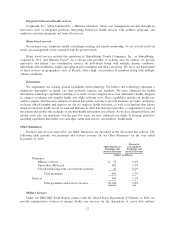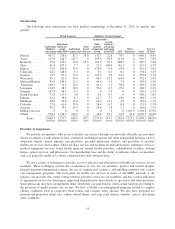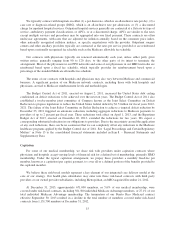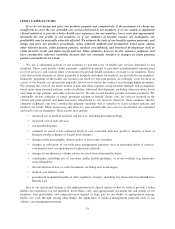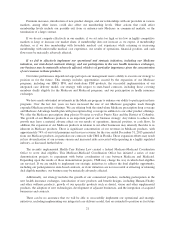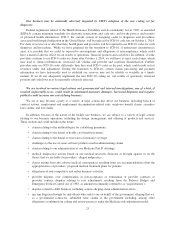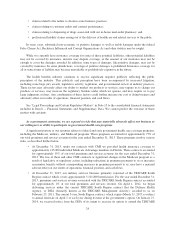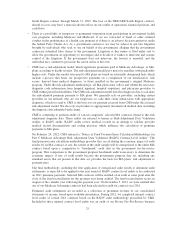Humana 2013 Annual Report Download - page 32
Download and view the complete annual report
Please find page 32 of the 2013 Humana annual report below. You can navigate through the pages in the report by either clicking on the pages listed below, or by using the keyword search tool below to find specific information within the annual report.growth or that the products we design will be accepted or adopted in the time periods assumed. Failure to
implement this strategy may result in a material adverse effect on our results of operations, financial position,
and cash flows.
If we fail to properly maintain the integrity of our data, to strategically implement new information
systems, to protect our proprietary rights to our systems, or to defend against cybersecurity attacks, our
business may be materially adversely affected.
Our business depends significantly on effective information systems and the integrity and timeliness of the
data we use to run our business. Our business strategy involves providing members and providers with easy to
use products that leverage our information to meet their needs. Our ability to adequately price our products and
services, provide effective and efficient service to our customers, and to timely and accurately report our
financial results depends significantly on the integrity of the data in our information systems. As a result of our
past and on-going acquisition activities, we have acquired additional information systems. We have reduced the
number of systems we operate, have upgraded and expanded our information systems capabilities, and are
gradually migrating existing business to fewer systems. Our information systems require an ongoing commitment
of significant resources to maintain, protect, and enhance existing systems and develop new systems to keep pace
with continuing changes in information processing technology, evolving industry and regulatory standards, and
changing customer preferences. If the information we rely upon to run our businesses was found to be inaccurate
or unreliable or if we fail to maintain effectively our information systems and data integrity, we could have
operational disruptions, have problems in determining medical cost estimates and establishing appropriate
pricing, have customer and physician and other health care provider disputes, have regulatory or other legal
problems, have increases in operating expenses, lose existing customers, have difficulty in attracting new
customers, or suffer other adverse consequences.
We depend on independent third parties for significant portions of our systems-related support, equipment,
facilities, and certain data, including data center operations, data network, voice communication services and
pharmacy data processing. This dependence makes our operations vulnerable to such third parties’ failure to
perform adequately under the contract, due to internal or external factors. A change in service providers could
result in a decline in service quality and effectiveness or less favorable contract terms which may adversely affect
our operating results.
We rely on our agreements with customers, confidentiality agreements with employees, and our trade
secrets and copyrights to protect our proprietary rights. These legal protections and precautions may not prevent
misappropriation of our proprietary information. In addition, substantial litigation regarding intellectual property
rights exists in the software industry, including litigation involving end users of software products. We expect
software products to be increasingly subject to third-party infringement claims as the number of products and
competitors in this area grows.
A cybersecurity attack that bypasses our information technology, or IT, security systems causing a security
breach may lead to a material disruption of our IT business systems and/or the loss of business information. If a
cybersecurity attack were to be successful, we could be materially adversely affected due to the theft, destruction,
loss, misappropriation or release of confidential data or intellectual property, operational or business delays
resulting from the disruption of our IT systems, or negative publicity resulting in reputation or brand damage
with our customers, brokers, agents, providers, and other stakeholders.
There can be no assurance that our IT process will successfully improve existing systems, develop new
systems to support our expanding operations, integrate new systems, protect our proprietary information, defend
against cybersecurity attacks, or improve service levels. In addition, there can be no assurance that additional
systems issues will not arise in the future. Failure to adequately protect and maintain the integrity of our
information systems and data, or to defend against cybersecurity attacks, may result in a material adverse effect
on our results of operations, financial position, and cash flows.
22


